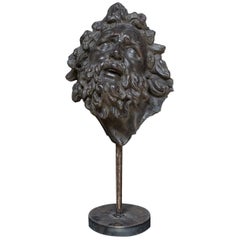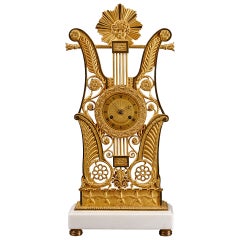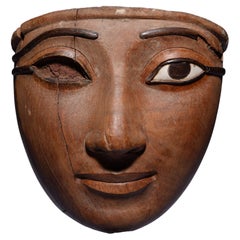Raffaello Romanelli Mounted Objects
2
to
2
2
2
Height
to
Width
to
2
2
1
2
2
46
155
125
60
52
Creator: Raffaello Romanelli
Apollo Belvedere Mask
By Raffaello Romanelli
Located in Milan, IT
A superb addition to a personal collection or a magnificent gift for a lover of antiquity, this mask reproduces in stunning detail the iconography of the Greek god Apollo...
Category
2010s Italian Raffaello Romanelli Mounted Objects
Materials
Bronze, Iron
Laocoonte Mask
By Raffaello Romanelli
Located in Milan, IT
This superb decorative piece rests on a metal pedestal and reproduces in bronze a detail of the marble sculptural group entitled Laocoon and His Sons...
Category
2010s Italian Raffaello Romanelli Mounted Objects
Materials
Metal, Bronze
Related Items
French Restauration Period Ormolu Lyre Mantel Clock with Apollo Mask
Located in Worpswede / Bremen, DE
An unusual French Restauration period ormolu mantel clock. The elaborately pierced gilt bronze case in the form of a lyre, with an Apollo mask cresting, on a white marble stepped bas...
Category
19th Century French Empire Antique Raffaello Romanelli Mounted Objects
Materials
Marble, Bronze
Exceptional Egyptian Sarcophagus Mask
Located in London, GB
Exceptionally Fine Wooden Sarcophagus Mask
Third Intermediate Period, 21st Dynasty, circa 1069-945 BC.
Acacia wood, rosewood, hippopotamus ivory
Masterfully carved from a single piece of fine-grained hardwood, the present mask is characteristic of the most exquisite funerary art made during the 21st Dynasty, and was probably commissioned for a particularly high-ranking individual.
The oval face displays a gently smiling mouth with full, outlined lips, furrows at the corners and a bow-shaped philtrum. The straight nose with rounded nostrils, the cheeks full and fleshy and the large, almond shaped eyes with heavy lids and tapering cosmetic lines, set below long, sweeping eyebrows.
Social collapse across the Mediterranean in the Late Bronze Age meant that the 21st Dynasty in Egypt was a period of great turmoil. Trade routes were disrupted, governments collapsed, and mass migration occurred. Economic scarcity meant that traditional funerary practices in Egypt were also affected, with a lack of material and financial resources leading to the reuse of preexisting material. As a result, during the 21st Dynasty, 19th and 20th Dynasty coffins changed ownership rapidly and were heavily recycled for new purposes. Tombs were also unmarked allowing them to be shared
by many people. These new practices brought forth a shift in the understanding of funerary paraphernalia. No longer important objects owned forever by the deceased, they were now simply seen as short-term transformative devices, whose symbolic and ritualistic meaning could be appropriated for others. However, paradoxically, the art of coffin-making also reached new heights during this period, and many of the richly dec- orated “yellow” coffins, characteristic of the 21st Dynasty, are remarkable works of art in their own right. Indeed, knowing that coffins were being reused throughout Egypt, the Egyptian élite set themself apart by commissioning lavish sarcophagi decorated with the images and texts meant to help guide them to the afterlife, and which would otherwise have adorned the tomb walls. As coffins were the chief funerary element which now identified the dead and allowed them a physical presence in the world of the living, their quality and appearance were of the utmost importance.
The traditional coffin ensemble was made of three parts: a wooden mummy cover, which laid directly atop the mummy, an inner coffin, and an outer coffin, both made of a lid and case. Additional decorative elements, such as masks, were carved out separately and later glued or pegged to the lids. After the completion of the painted decoration, the sarcophagus was covered in a varnish to give it its yellow colour. Gilding was sometimes used for the coffins of the high priests’ families, notably on parts representing naked skin, such as the face mask. However, some of the élite tactically avoided gilding altogether as to ensure that their coffin would not be looted.
When manufacturing the inner and outer coffins, particular attention was paid to the woodwork. Displaying the skill of the carpenter, this type of funerary art has largely remained unparalleled throughout Egyptian history. The principal wood used to craft the present mask is Acacia nilotica. The evergreen Egyptian acacia was considered sacred and said to be the tree of life, the birthplace of the god Horus, as well as symbolic of Osiris, the god of the dead and resurrection. The modelling of the face in the wood is superb, but the inlays also help mark this mask out as exceptional. Inlaid eyes and eyebrows were extremely rare and reserved to the finest and most expensive coffins. Traditionally, eyes were made of calcite, obsidian, or quartz, and eyebrows of coloured glass paste or bronze. Here, the pupils, eyebrows, and cosmetic lines are inlaid with Dalbergia melanoxylon, a rare type of wood which belongs to the rosewood genus.
In antiquity, however, it was known as Ebony of the Pharaohs, from the Egyptian word “hbny”, meaning dark timber, because of its black, lustrous appearance. An extremely dense and hard wood requiring significant skill to work with, ebony was a luxury material highly coveted by the pharaohs themselves, to make furniture, decorative and funerary objects. The wood was imported with great effort from the southern Land of Punt, most likely modern Sudan, Ethiopia, Djibouti, and Eritrea, alongside other luxury goods such as gold and ivory.
A magnificent ebony throne, recovered in the tomb of King Tutankhamun, illustrates the incredible aesthetic potential of this material and why it was so highly valued by Egyptian royalty. Only élite members of Egyptian society could have afford- ed Ebony of the Pharaoh inlays for their funerary mask.
The sclerae on the present piece were once both inlaid with hippopotamus ivory. Whiter than elephant ivory, this type of ivory is also denser, and more difficult to carve. The use of this luxury material, reputed for its gleaming appearance, enhances the lifelikeness of the eyes. For the Egyptians, hippopotamus ivory was imbued with magic powers. The hippopotamus was indeed both feared and venerated due to its aggressive behaviour. Whilst the male hippopotamus was associated with danger and chaos, the female was benevolent and invoked for protection, especially of the house and
of mothers and their children, through the hippopotamus goddess Tawaret. Thus, not only was hippopotamus ivory used as an inlay and to make practical objects, such as combs and clappers, but it was also used to make talismans like apotropaic wands or knives.
Made during a time of scarcity where few could afford made-to-order coffins, the present mask could have only belonged to one of the highest-ranking individuals in society. Undoubtedly one of the finest Egyptian coffin...
Category
15th Century and Earlier Egyptian Egyptian Antique Raffaello Romanelli Mounted Objects
Materials
Fruitwood, Hardwood
19th Century English Diminutive Parian Bust of Apollo Belvedere
Located in West Palm Beach, FL
19th century English diminutive Parian bust of apollo Belvedere, a well executed example, raised on a 3-inch diameter solace base. Unmarked.
Category
Late 19th Century English Classical Roman Antique Raffaello Romanelli Mounted Objects
Materials
Ceramic
Ceramic Face Mask Wall Sculpture
By Asmaa Aman-Tran
Located in Stoughton, MA
A true embodiment of the Artist's style of combining different mediums, this wall sculpture echoes a festive moment in time, Drawing inspiration from the Artist's moroccan roots. This sculpture is an hommage to the talented women weavers of Morocco that the artist got to meet on her last weaving in retreat in Marrakech.
This wall hanging shaped out of hand wrapped manila rope using naturally dyed recycled silk yarn, sisal and. raffia. The ceramic face...
Category
2010s Tribal Raffaello Romanelli Mounted Objects
Materials
Ceramic, Silk, Hemp, Raffia
Bronze Bust of Apollo Belvedere Grand Tour, 19th Century
Located in Rochester, NY
Superb 19th century bronze and gilt bronze bust of the god Belvedere Apollo, circa 1850. This wonderful Grand Tour bust is a marvel of refined beauty and elegance, crafted with richl...
Category
19th Century European Antique Raffaello Romanelli Mounted Objects
Materials
Marble, Bronze
Ceramic Face Mask Wall Tapestry
By Asmaa Aman-Tran
Located in Stoughton, MA
A true embodiment of the Artist's style of combining different mediums, this wall sculpture echoes a festive moment in time, Drawing inspiration from the Artist's moroccan roots. This sculpture is an hommage to the talented women weavers of Morocco that the artist got to meet on her last weaving in retreat in Marrakech.
Handwoven with raffia and jute. The ceramic face...
Category
2010s Tribal Raffaello Romanelli Mounted Objects
Materials
Ceramic, Silk, Hemp, Raffia
Patinated plaster sculpture after Apollo di Belvedere, late 19th Century
Located in Knivsta, SE
Beautiful patinated plaster sculpture after Apollo di Belvedere made during the late 19th Century.
Provenance from Lennartsnäs Castle, near Stockholm, Sweden, Baron af Ugglas. The ...
Category
Late 19th Century European Antique Raffaello Romanelli Mounted Objects
Materials
Plaster
Free Shipping
H 21.26 in W 14.57 in D 10.24 in
Ferdinando Vichi Lifesize Marble Figure "Apollo Belvedere"
Located in Los Angeles, CA
Ferdinando Vichi (Italian, 1875-1945) A fine and lifesize Italian white Carrara marble Greco-Roman figure of the Belvedere Apollo, after the original, now in the Vatican Museum, the Belvedere Apollo has defined the Greek aesthetic ideals of harmony, noble simplicity and quiet grandeur. Apollo is depicted as an archer, having just killed the Python of Delphi. The carved figure displays the tension lingering as if the arrow has just left his bow. Standing on an oval base inscribed: F. Vichi, Firenze, Made in Italy. Florence, circa 1895-1900.
Measures: Height 68 inches (192 cm)
Width 47 1/4 inches (120 cm)
Depth 38 1/2 inches (97.8 cm)
Width of base 25 inches (63.5 cm)
Former Property of Adolph Henrich Joseph Sutro's famous Cliff House and indoor public swimming establishment, The Sutro Baths...
Category
19th Century Italian Greco Roman Antique Raffaello Romanelli Mounted Objects
Materials
Carrara Marble
Chinese or Korean Antique Wooden Large Mask/1800s/Festival Mask/Dance Mask
Located in Sammu-shi, Chiba
This is a very old wooden mask made in China or Korea, probably around the 1800s.
Many masks are also made in Japan, and their roots are said to come from China.
Famous items include...
Category
19th Century Chinese Other Antique Raffaello Romanelli Mounted Objects
Materials
Wood
H 17.52 in W 16.54 in D 6.7 in
Plaster Cast of a Woman's Mask
Located in Greding, DE
Plaster cast of a woman's mask made after an antique model. Provenance: Hohenzollernschloss Sigmaringen.
Category
20th Century Unknown Raffaello Romanelli Mounted Objects
Materials
Plaster
Neoclassical Plaster Busts of Diana and Apollo Belvedere Sculptures, Pair
Located in Elkhart, IN
A gorgeous pair of cast plaster Neoclassical Grand Tour style male and female head busts of Diana and Apollo Belvedere god and goddess sculptures
USA, 21st Century
Measures: 8"W x ...
Category
21st Century and Contemporary American Neoclassical Raffaello Romanelli Mounted Objects
Materials
Plaster
French Bronze Figure of the Apollo Belvedere
Located in New York, NY
Stamped A.V., on a square red marble base.
Category
19th Century French Antique Raffaello Romanelli Mounted Objects
Materials
Bronze
Raffaello Romanelli mounted objects for sale on 1stDibs.
Raffaello Romanelli mounted objects are available for sale on 1stDibs. These distinctive items are frequently made of metal and are designed with extraordinary care. There are many options to choose from in our collection of Raffaello Romanelli mounted objects, although gold editions of this piece are particularly popular. If you’re looking for additional options, many customers also consider mounted objects by and Costantini. Prices for Raffaello Romanelli mounted objects can differ depending upon size, time period and other attributes — on 1stDibs, these items begin at $3,770 and can go as high as $4,085, while a piece like these, on average, fetch $3,928.



